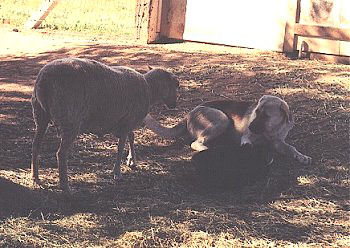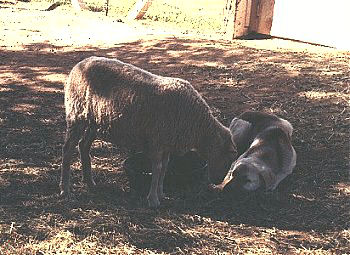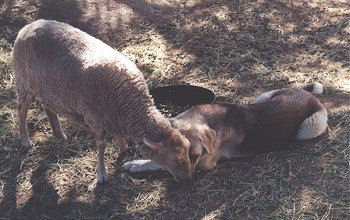![[LOGO]](sm-logo.gif)
![]()
Early Training:
Socialization from Four to Six Months
by Jennifer Floyd
As originally published in
Choban Chatter
While growing up, your pup should be spending most of his or her time in the sort of situations that it will be expected to be familiar with as an adult. If a companion dog, that means spending a lot of time meeting all sorts of people, young & old; the initial socialization can be made up of friends and aquaintences at home, but once your pup has all of its initial immunizations, socialization should include lots of rides in the car, training sessions near stores, in parks, and other busy places. If a flock guardian, your pup needs to know how to interact with the stock, and be introduced to whatever species it will be expected to protect.
As there is already quite a bit of literature about socializing the human-bonded dog (How to Raise a Puppy You Can Live With 3rd. Ed., by Rutherford and Neil, is an excellent book), I will hereafter concentrate on the development of a flock guardian.
 Belligerent ewe approaches pup. Pup shows submission. |
Ideally, your pup will be introduced to the stock by following you around when you are doing basic chores. This way, if the pup tries to play with or mouth the stock (as they would with a fellow puppy), you are right there to correct them with a "No!", or by rolling them over on the ground and holding there a moment, telling them "Leave it!" Voice corrections are usually very effective with younger pups, and I only roll them if they are ignoring the voice. |
| Be careful that young pups are not seriously frightened of, or injured by the stock - a ram could do serious damage, and some ewes will back a pup into a corner to butt them. I supervise early interactions closely, until the flock is accustomed to the new dog, and the pup knows to stay out of the way. |  Pup wiggles forward on stomach, trying to be ingratiating. |
When not directly supervised, the pup should have its own training and sleeping pen, where he or she has shelter, and can be close to the stock and observe and bond with them. This can be a simple as a few livestock panels wired to some T posts, or a portable chainlink kennel also works well. This pen should be right where the flock eats, or otherwise spends a lot of their time - if your flock ranges over a wide area, you may want to temporarily pen a few individuals next to the pup for it to bond with. Younger animals or wethers are usually a good choice.
 Pup cuddles up to ewe and ewe accepts her. |
The sorts of behavior that you want to see with your pup are: lying quietly near the flock, walking slowly around the flock, lowering head and tail if they move through the flock, and showing submissive behavior to the sheep (see accompanying photos of 5 month old pup with yearling Shetland ewe). The pup may circle the flock with head and tail up when responding to a threat, but not in response to the sheep. |
By the time the pup is around six months old, if they have been exhibiting responsible behaviors, you may be able to start leaving them with the flock for longer periods; if you have active young lambs, though, you will probably want to continue supervising, as the pup may be able to avoid initiating play behaviors, but if invited to do so by bouncy little animals, the temptation may be too much. Wait until later (maybe next lambing season), if you have a very young pup and lambs at the same time, to let them be together.
The main focus of the training and bonding process, is to avoid letting the pup fall into error. Fix any mistakes right away, and you won't have retraining problems later.
| Previous: 1-4 months | Next Issue: Adolescence |

This page copyright by Anatolian Shepherd Dogs International, Inc. ® .
